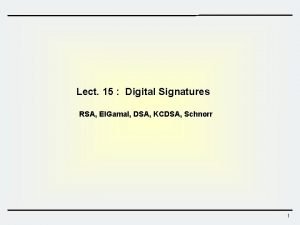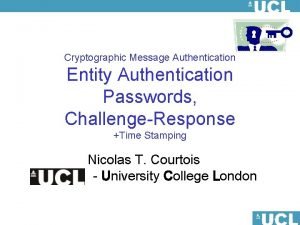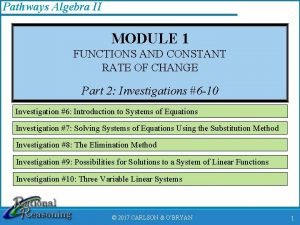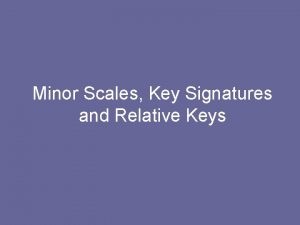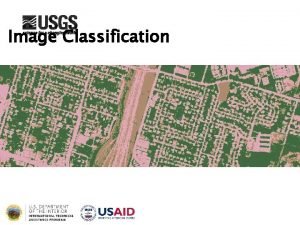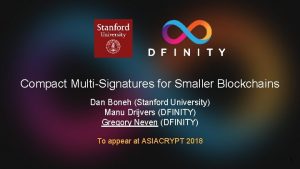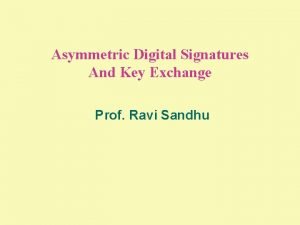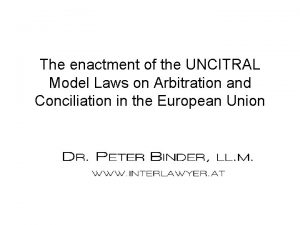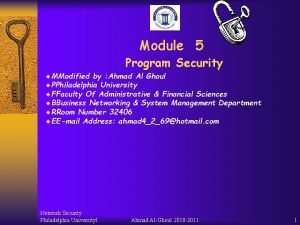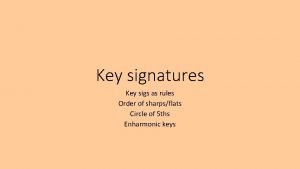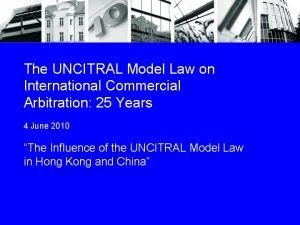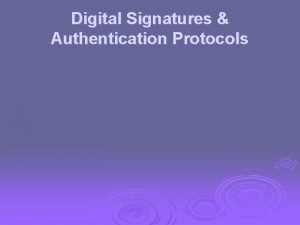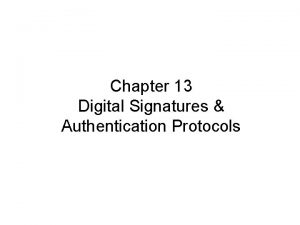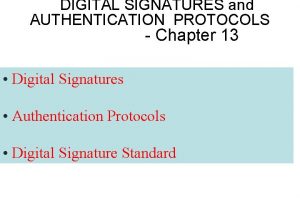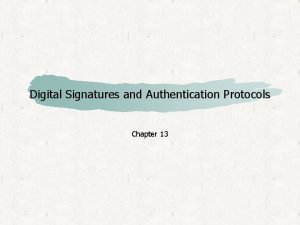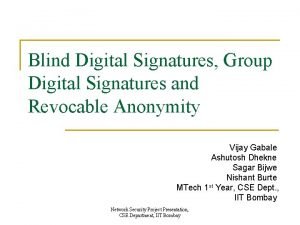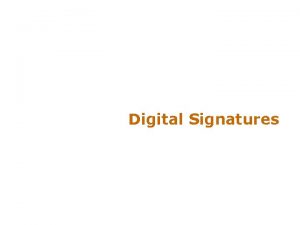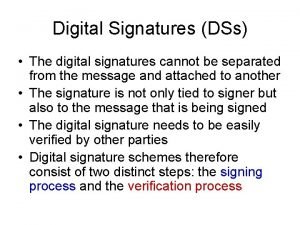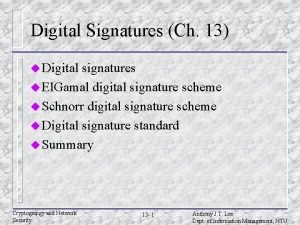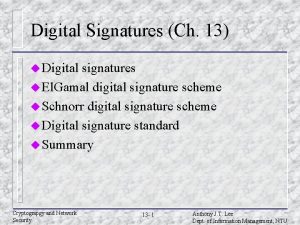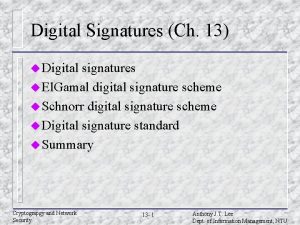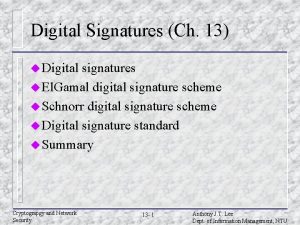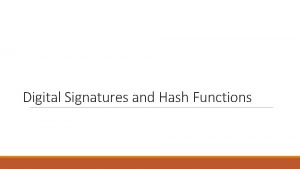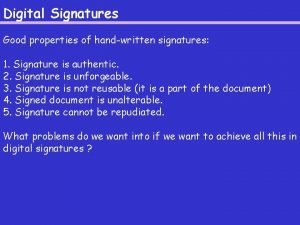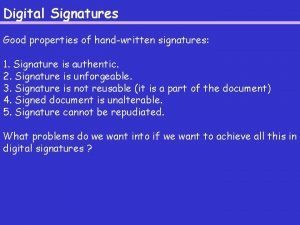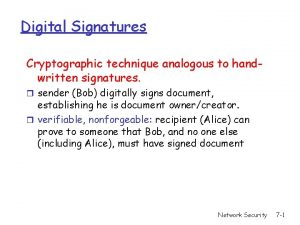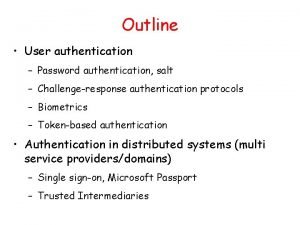Chapter 13 Digital Signatures Authentication Protocols Fourth Edition















![Public-Key Approaches • if confidentiality is a major concern, can use: A->B: EPUb[Ks] || Public-Key Approaches • if confidentiality is a major concern, can use: A->B: EPUb[Ks] ||](https://slidetodoc.com/presentation_image_h2/d149b9b17f1adb880f25e4311a8d0631/image-16.jpg)





- Slides: 21

Chapter 13 – Digital Signatures & Authentication Protocols Fourth Edition by William Stallings Lecture slides by Lawrie Brown (modified by Prof. M. Singhal, U of Kentucky) 1

Digital Signatures • have looked at message authentication – but does not address issues of lack of trust • digital signatures provide the ability to: – verify author, date & time of signature – authenticate message contents at the time of signature – Must be verifiable by third parties to resolve disputes 2

Digital Signature Properties • must depend on the message signed • must use information unique to sender – to prevent both forgery and denial • must be relatively easy to produce • must be relatively easy to recognize & verify • be computationally infeasible to forge – with new message for existing digital signature – with fraudulent digital signature for given message • be practical save digital signature in a storage 3

Direct Digital Signatures • involves only the parties: sender and receiver • assumed receiver has sender’s public-key • digital signature made by sender signing entire message or hash with private-key • can encrypt using receivers public-key • important that sign first then encrypt message & signature • security depends on sender’s private-key 4

Arbitrated Digital Signatures • involves use of arbiter A – Sender sends the signed message to arbiter – validates any signed message – then dated and sent to recipient • requires suitable level of trust in arbiter • can be implemented with either private or public-key algorithms • arbiter may or may not be able to see message 5

Authentication Protocols • used to convince parties of each others identity and to exchange session keys • may be one-way or mutual • key issues in authenticated key exchange: – confidentiality – to protect session keys – timeliness – to prevent replay attacks • published protocols are often found to have flaws and need to be modified 6

Replay Attacks • where a valid signed message is copied and later resent – simple replay (simply copy and replay later) – repetition that can be logged (replay a timestamped message within its valid time window) – repetition that cannot be detected (the original message is suppressed and only replayed message arrives at the destination) – backward replay without modification (a message is replayed back to the sender; can work if symmetric encryption is used) 7

Replay Attacks • countermeasures include – use of sequence numbers (generally impractical– each party must remember the last sequence for every other person) – timestamps (needs synchronized clocks) – challenge/response (using unique nonce) 8

Using Symmetric Encryption • as discussed previously, we can use a two -level hierarchy of keys • usually with a trusted Key Distribution Center (KDC) – each party shares own master key with KDC – KDC generates session keys used for connections between parties – master keys used to distribute these to them 9

Needham-Schroeder Protocol • does key distribution using a KDC • Also performs authentication • for session between A and B mediated by KDC, protocol overview is: 1. A->KDC: IDA || IDB || N 1 2. KDC -> A: EKa[Ks || IDB || N 1 || EKb[Ks||IDA] ] 3. A -> B: EKb[Ks||IDA] 4. B -> A: EKs[N 2] 5. A -> B: EKs[f(N 2)] 10

Needham-Schroeder Protocol • used to securely distribute a new session key for communications between A & B • vulnerable to a replay attack if an old session key has been compromised – then message 3 can be resent convincing B that is communicating with A • modifications to address this require: – timestamps (Denning 81) – using an extra nonce (Neuman 93) 11

Using Public-Key Encryption • have a range of approaches based on the use of public-key encryption • need to ensure have correct public keys for other parties • using a central Authentication Server (AS) • various protocols exist using timestamps or nonces 12

Denning AS Protocol • Denning 81 presented the following: 1. A -> AS: IDA || IDB 2. AS -> A: EPRas[IDA||PUa||T] || EPRas[IDB||PUb||T] 3. A -> B: EPRas[IDA||PUa||T] || EPRas[IDB||PUb||T] || EPUb[EPRas[Ks||T]] • note session key is chosen by A, hence AS need not be trusted to protect it • timestamps prevent replay but requires synchronized clocks 13

One-Way Authentication • required when sender & receiver are not in communications at same time (e. g. , email) • have header in clear so can be delivered by email system • may want contents of body protected & sender authenticated 14

Using Symmetric Encryption • One-way authentication protocol: 1. A->KDC: IDA || IDB || N 1 2. KDC -> A: EKa[Ks || IDB || N 1 || EKb[Ks||IDA] ] 3. A -> B: EKb[Ks||IDA] || EKs[M] • does not protect against replays – could rely on timestamp in message, though email delays make this problematic 15
![PublicKey Approaches if confidentiality is a major concern can use AB EPUbKs Public-Key Approaches • if confidentiality is a major concern, can use: A->B: EPUb[Ks] ||](https://slidetodoc.com/presentation_image_h2/d149b9b17f1adb880f25e4311a8d0631/image-16.jpg)
Public-Key Approaches • if confidentiality is a major concern, can use: A->B: EPUb[Ks] || EKs[M] – has encrypted session key, encrypted message • if authentication needed, use a digital signature with a digital certificate: A->B: M || EPRa[H(M)] || EPRas[T||IDA||PUa] – with message, signature, certificate 16

Digital Signature Standard (DSS) • A digital signature function (can not be used for encryption or key exchange) • US Govt approved signature scheme • designed by NIST & NSA in early 90's • published as FIPS-186 in 1991 • revised in 1993, 1996 & then 2000 • uses the SHA hash algorithm • DSS is the standard, DSA is the algorithm • FIPS 186 -2 (2000) includes alternative RSA & elliptic curve signature variants 17

Digital Signature Algorithm (DSA) • • creates a 320 bit signature smaller and faster than RSA a digital signature scheme only security depends on difficulty of computing discrete logarithms 18

Digital Signature Algorithm (DSA) 19

Digital Signature Algorithm (DSA) • a. b. c. d. • • Sig: a signature function that has four inputs: Hash H A random number k Private key of the sender A global public key (known to a group of communicating principals) The signature consists of two parts, r and s. At the receiver side, verification is done. 20

Summary • have discussed: – digital signatures – authentication protocols (mutual & one-way) – digital signature algorithm and standard 21
 El gamal signature
El gamal signature Peer entity authentication and data origin authentication
Peer entity authentication and data origin authentication Iff
Iff Project 2 fourth edition
Project 2 fourth edition Algebra 2 module 1 answer key
Algebra 2 module 1 answer key Ethics in information technology fourth edition
Ethics in information technology fourth edition Ethics in information technology fourth edition
Ethics in information technology fourth edition Vertical line html
Vertical line html A computer programming team has 13 members
A computer programming team has 13 members Expert systems: principles and programming, fourth edition
Expert systems: principles and programming, fourth edition Parallel key signatures
Parallel key signatures Spectral signatures
Spectral signatures Compact multi-signatures for smaller blockchains
Compact multi-signatures for smaller blockchains Exchange 2007 signatures
Exchange 2007 signatures Uncitral model law on electronic signatures
Uncitral model law on electronic signatures Intruders use virus signatures fabricate
Intruders use virus signatures fabricate Key signature rules
Key signature rules Uncitral model law on electronic signatures
Uncitral model law on electronic signatures Ocaml signatures
Ocaml signatures Natural selection
Natural selection Code c
Code c Digital signature authentication protocol
Digital signature authentication protocol
